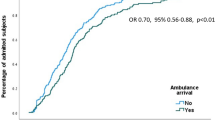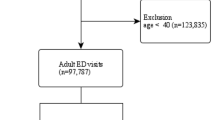Abstract
Studies on observation unit (OU) use to avoid a hospital admission from the emergency department (ED) have found variable effects on health care resource utilization, and these effects have not been studied in acute exacerbation of chronic obstruction pulmonary disease (AECOPD). We retrospectively collected data for all AECOPD-related ED visits (age > 40) to an urban, academic medical center between February 2013 and April 2017. We examined the total proportion of visits admitted to the hospital before and after availability of an OU and the proportion of visits discharged directly from the ED using segmented regression analysis. There was a 12.8% reduction in hospital admissions after OU availability (79.6 vs. 66.8%, p = 0.0049) without a change in the proportion discharged directly from the ED (p = 0.65). The availability of an OU can decrease hospital AECOPD admissions without affecting the number of patients discharged directly from the ED.

Similar content being viewed by others
References
Baugh CW, Bohan JS (2014) Emergency department observation units. In: Emergency department leadership and management: best principles and practice. Cambridge University Press, Cambridge, pp 234–246
Mace SE et al (2003) A national survey of observation units in the United States. Am J Emerg Med 21(7):529–533
Graff L (2009) Observation medicine: the healthcare system’s tincture of time. American College of Emergency Physicians, p 176
Abbass IM et al (2015) Revisiting the economic efficiencies of observation units. Manag Care 24(3):46–52
Farkouh ME et al (1998) A clinical trial of a chest-pain observation unit for patients with unstable angina. N Engl J Med 339(26):1882–1888
Blecker S et al (2016) Observation units as substitutes for hospitalization or home discharge. Ann Emerg Med 67(6):706–713
Brillman JC, Tandberg D (1994) Observation unit impact on ED admission for asthma. Am J Emerg Med 12(1):11–14
Rosychuk RJ, Youngson E, Rowe BH (2016) Presentations to emergency departments for COPD: a time series analysis. Can Respir J 2016:1382434
Global Initiative for Chronic Obstructive Lung Disease. 2016. http://www.goldcopd.org
Dickey DA (2015) Stationarity issues in time series models. North Carolina State University, paper, p 192-30
Wagner AK et al (2002) Segmented regression analysis of interrupted time series studies in medication use research. J Clin Pharm Ther 27(4):299–309
Zun L (1990) Observation units: boom or bust for emergency medicine. J Emerg Med 8(4):485–490
Marshall JR et al (2017) Use of physician-in-triage model in the management of abdominal pain in an emergency department observation unit. West J Emerg Med 18(2):181–188
Author information
Authors and Affiliations
Corresponding author
Ethics declarations
Conflict of interest
The authors declare that they have no conflict of interest.
Rights and permissions
About this article
Cite this article
Budde, J., Agarwal, P., Mazumdar, M. et al. Can an Emergency Department Observation Unit Reduce Hospital Admissions for COPD Exacerbation?. Lung 196, 267–270 (2018). https://doi.org/10.1007/s00408-018-0102-1
Received:
Accepted:
Published:
Issue Date:
DOI: https://doi.org/10.1007/s00408-018-0102-1




